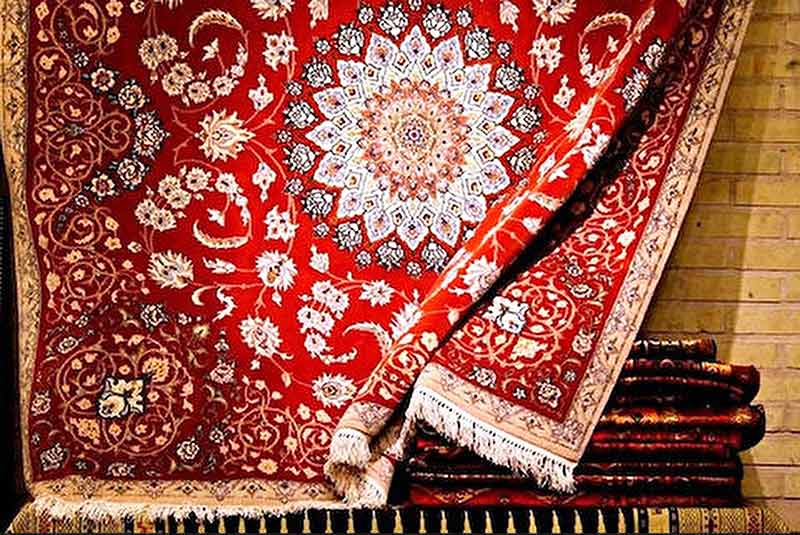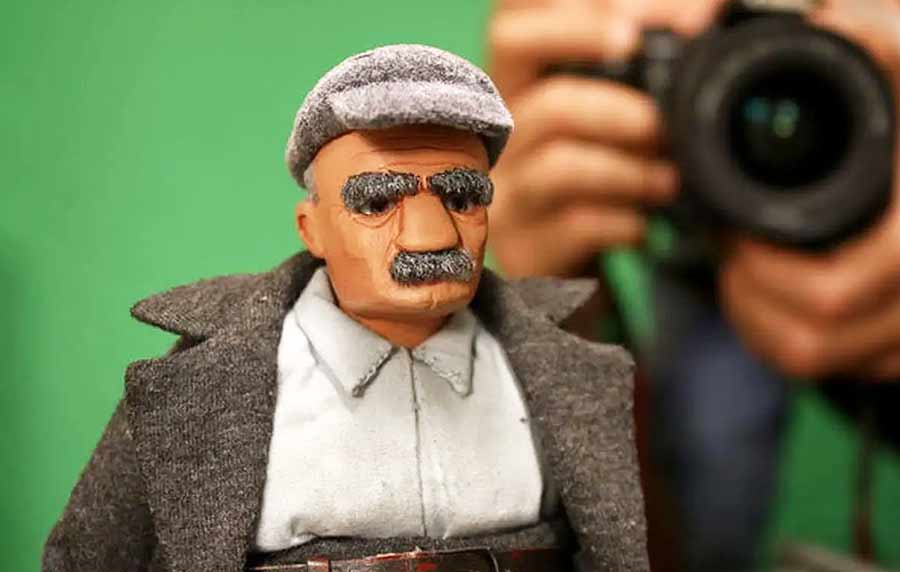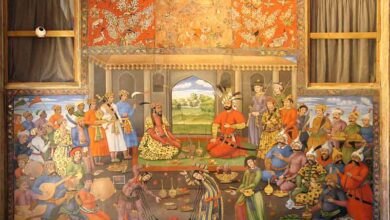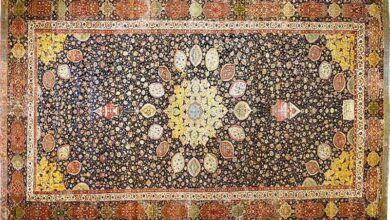Aesthetics and its reflection in Iranian hand-woven carpets

The arts are born of thought in the realm of culture and social environment. In the meantime, the industrial art of carpet is also influenced by intellectual and cultural tendencies.
Some arts, such as Carpet Art with a long history, go back centuries and continue to play a role in life. It should be noted that these arts have used a variety of different approaches and ideas at any time, or are largely in harmony with a particular religion or culture.
The beauty of Iranian carpets is one of the factors that has made it last in the art world. Knowing the basis of such beauties facilitates the evaluation of the carpet and provides appropriate criteria for this evaluation. Also, recognizing and applying the factors affecting the quality and beauty of Iranian carpets will help its immortality. Therefore, it is necessary to know the set of elements and factors that make Iranian carpets beautiful. And categorized, defined and introduced according to priority.
Just as all the arts are influenced by the thought of the artists, culture and philosophy of their time, so is the art of carpet influenced by the intellectual space of its artist and the cultural and aesthetic tendencies and approaches of its environment. Due to its antiquity, this industrial art has gone through various fields and has been confronted with many thoughts and ideas. The aesthetics of Iranian carpets have been mainly influenced by “symbolism”, but “naturalism” is thought-provoking in the aesthetics and design of some carpets.
The human mind today has a precise scientific appeal, and in this respect it is quite different from the human mind of primitive societies, which was quite sensory. For this reason, mythical and symbolic beliefs were strong in the minds of primitive man. Attitude towards beauty in it according to the common structure of man and nature; Which is measurable through mathematics. Nature is the primary source of inspiration for the artist and the agent of the mind’s imagination and role-playing. In this connection, it is enough for the artist to know the language of communication. In that case, by understanding the forms of nature, the figures depicted in their existence figure out. And it is in this way that role-playing is considered proportionate. And according to it, the tone of the work is created and the role is created, which is the role of arranging the shapes, in line with the visual culture of the community.
Beauty is one of the houses that art must pass through and reach a higher level. In this view, the intellect perceives beauty and the meaningful sense of this perception touches beauty.
In Islamic thought, the basis of beauty and aesthetics goes back to God. The soul and thought of the Iranian artist is Islamic, religious, and such a belief is manifested in his artwork. Therefore, it should be borne in mind that the knowledge of art and beauty in Islamic thought is different from its common meaning in the West, which began in the eighteenth century. The principles of art and beauty in Islam are completely mystical and subject to the spiritual attitude of Muslims towards truth, existence, man and the world. In this attitude of the beautiful man, the truth depicts the beauty of God.
Definitions of Beauty
According to the definition of the Persian Thesaurus Amid, “beautiful means beautiful, good, good, good, ugly, beautiful: beauty: being beautiful, good. “It is found, it is discussed, and it is the science of beauty.”
Plato considers beauty and the human perception of beauty in the quality of human actions or the practical aspect of life. “Everything that is done in a beautiful way is beautiful, and if it is done in an ugly way, it is ugly.”
He considers that creating harmony between the elements is effective in instilling a sense of beauty in a person: “Two things that are opposite to each other cannot be compatible as long as this contradiction remains between them, they must be united in some way to create harmony.” .
Creating this feeling in us helps to identify our desires.
He defines beauty as follows: “Beauty is always there, it does not disappear, it does not get bigger or smaller”. It is not nature to be beautiful in one way and ugly in another, or to be beautiful now and not beautiful at another time, or to be beautiful in comparison to something. And be ugly compared to another or be beautiful in one place and ugly in another. Or in the opinion of some beautiful and in the opinion of others ugly. Beauty is something that exists with and for itself, eternal and absolute. Every beautiful thing benefits from beauty in some way.
Truly, the Iranian aesthetic artist is in love, he has a good desire, and this love and goodness leads him to the unlimited valley of creating beauty. Aesthetics can be considered as the knowledge of the general laws of art and the science of the nature of artistic creation. And art can be the most perfectly reflected form of beauty from reality. Aesthetic perception is a complex issue, meaning that both emotional and intellectual factors are involved. In his book Critique of Aesthetic Judgment, Kant distinguishes between quoting and judging on the subject matter. Taste judgments, regardless of utilitarian affiliation and pleasant judgment, relate to the use of our external senses.
In order to perceive beauty and the criteria for recognizing the work of beauty, we must examine and believe in the basic and common features of the work, and in order to receive aesthetic criteria, we must become aware of the society and the time in which the work of art was created.
The knowledge of artistic beauty differs from that of Eastern thinkers, especially Iranian and Islamic thinkers, from what exists about the aesthetics of artistic subjects in the West. In this view, “art is the place of emergence of the ventricle in which feeling and beauty are realized.”
Aesthetic creation is the offspring of deep spiritual cognition which, although it starts from the lowest level of human love in the earthly world, leads to the highest degree of spiritual passion, and the manifestation of this cognition and state of the path ends in the development of truth in the context of beauty. It is human.
The world in the work of art is not a world separate from man himself. This world is adjacent to his own world, and even when a person reaches its importance, it illuminates the knowledge of his existence. Beauty is truth, the truth of existence that manifests itself in us in art, and the content of the existence of art is the work in which the value of truth is clarified.
Aesthetic contemplation involves a kind of spiritualization. That is, the artist forces the mind of his audience to work, the culture with an aesthetic and artistic attitude, offers richer experiences of cognition to human beings and has the property of uplifting.
Among the important topics that the thinkers of the new era have raised and fostered in the field of aesthetic studies, history and philosophy of art, have been the categories of aesthetics – including beauty, glory, elegance, tragedy, comics and ugliness and their nature and appropriateness.
The concept of aesthetics has not been immune to harm and distortion, despite its special theoretical credibility in the new era. Conceptual pathology and its distortion, however, are very important in formulating theoretical discussions about the history and philosophy of art and our understanding of the aesthetic taste of different periods and cultures.
The world of art is the world of faces. Not every face, of course, but living symbolic and allegorical faces. The forms, shapes and themes that are the product of the free and creative action of human existence and the existential capabilities. According to Henry Foulcion, forms that have their own “life”. Of course, life is not in its physical or biological sense, but in a deeply existential, spiritual, spiritual and eternal sense.
We also mean forms, forms, themes, allegories and vivid images in the field of art and works of art and human artistic action; It is more than just the movement of words and phrases. His life represents forms and shapes, designs and roles and artistic and aesthetic themes. Art forms, because they are symbolic, allegorical, design, visual, and have a higher role and symbol of etiquette, also have the benefit of immortality, although they are symbolic, allegorical, and metaphorical on the face.
These forms and forms and themes are both the product of free and creative action and action of human existential capabilities, and they are the source of motivation and inspiration and the source of deep spiritual movements and developments in the audience. Motivation, inspiration and excitement, the descriptive burden of which always outweighs the other aspects.
Each period also includes Harry’s own taste and aesthetic taste. From these forms and shapes, the living themes are symbolic and allegorical, which shows how man basically felt the world and lived and thought in it in that period. These vivid faces, in spite of the diversity, theology, or the variety of styles, traditions, and ways of expression; Like historical experience or, in principle, human history, they have an internal and fundamental structural unity, and are not evolving into natural history.
For this reason, they have appeared and manifested in every period that has appeared and manifested in each of the “aesthetic categories”. Regardless of the age and wear and tear of time, they have been able to have a serious and sometimes profoundly transformative effect on our feelings, thoughts, mental actions, spiritual life, spiritual desires, and emotions.
Iranian Carpet
In Islamic thought, the principle of beauty and aesthetics goes back to God. The soul and thought of the artist is Iranian, Islamic and religious, and such a belief is manifested in his work of art. Understanding the beauty of Iranian handmade carpets is possible for everyone because Iranian carpets are a practical art and its daily use has made this art associated with people’s lives. Iranian carpet is a popular art and has simply entered their lives and been separated from class. Therefore, the soul and thought of the Iranian beauty lover can understand why the beauty of Iranian carpets and with this capability will add to the lasting values of this art.
Beauty has an appearance and interior in Iranian handmade carpets. The intention is to attribute the esoteric factors to the spiritual, spiritual and inner perceptions of the artist and to consider them as hidden in the heart of art. These factors mostly include the psychological, sociological characteristics and religious approaches of the artist. The most important beauty of the carpet is the design and pattern, color and dimensions. Design and role are one of the main factors in the beauty of Iranian carpets. And it has features that observe and apply them in the design, causing a beautiful image to appear in the mind of the audience.
The use of paint in carpets in any geographical region of Iran has special features. Therefore, Isfahan and Nain carpets are distinguished from Sistan or Tabriz or Fars carpets because the color, in addition to the design and pattern, gives the carpet a special identity in its geographical area.
The Beauty of Color
After the design and role, color is one of the most effective factors in the beauty of Iranian carpets. The use of natural and plant dyes in the past. It made the carpet better. With this method of dyeing the raw materials, it is stable against sunlight and washing, and their softness and radiance increase the quality of the carpet. However, the great difficulty of this dyeing method, its time consuming and the high cost of some dyes, gradually caused the boom of the chemical dyeing market. This means that the method and method of vegetable or chemical dyeing is an influential factor in the beauty of the carpet. But to study the beauty of color in Iranian carpets, factors related to the geography of the texture and observance of the principles and foundations of color in carpets are also among the important components.
The use of paint in carpets in any geographical region of Iran has special features. Therefore, Isfahan and Nain carpets are distinguished from Sistan or Tabriz or Fars carpets because the color, in addition to the design and pattern, gives the carpet a special identity in its geographical area. For example, the psychological and emotional effects of red and yellow create a state of expansion in human beings. And blue creates a state of contraction and stillness. Even the place of color, the color direction in the image, the extent of color surfaces, and the relationships of color contrasts with each other have the expressive values of color in composition.
Regarding the spiritual beauty of the carpet, which we mentioned under the influence of esoteric factors, various indicators also affect the beauty of the carpet. Such as the artistic intention and truth of the artist, intuition, imagination and inspiration, even religious beliefs and ideas. This is the spiritual dimension hidden in the spirit of the Iranian carpet, which reveals the balance between form and meaning in Iranian arts. Expressing the hidden and hidden secrets in the beauties of appearance will add depth to the inner beauties of the work of art and will immortalize the secret of its permanence.
In expressing the beauties of Iranian handmade carpets, it can be said that the face and meaning in Iranian handmade carpets are in great harmony. That is, the design and role, colors and dimensions as the face and appearance of the carpet arise from the culture and values of the designer and weaver of the carpet.
The use of roles such as leaves, trees, and… indicates the Iranian weaver and designer paying attention to the divine nature and the order and rule that governs this nature. The use of natural colors and matching the dimensions with the design and role of the carpet not only adds to its beauty, but also shows the living spirit of the designer and weaver of Iranian handmade carpets.
* Sources and references are available in the editorial office of Artmag.











